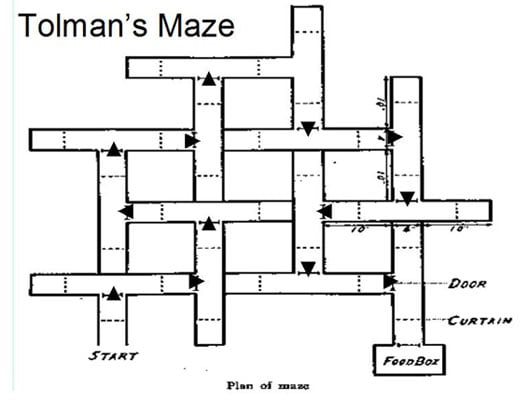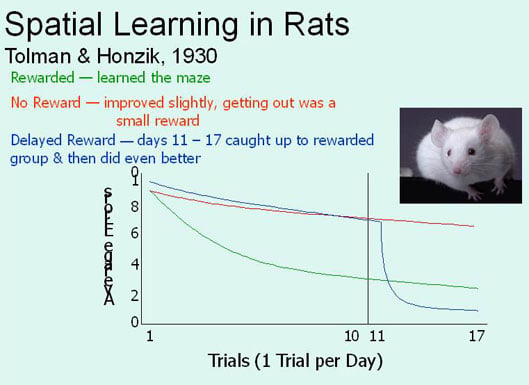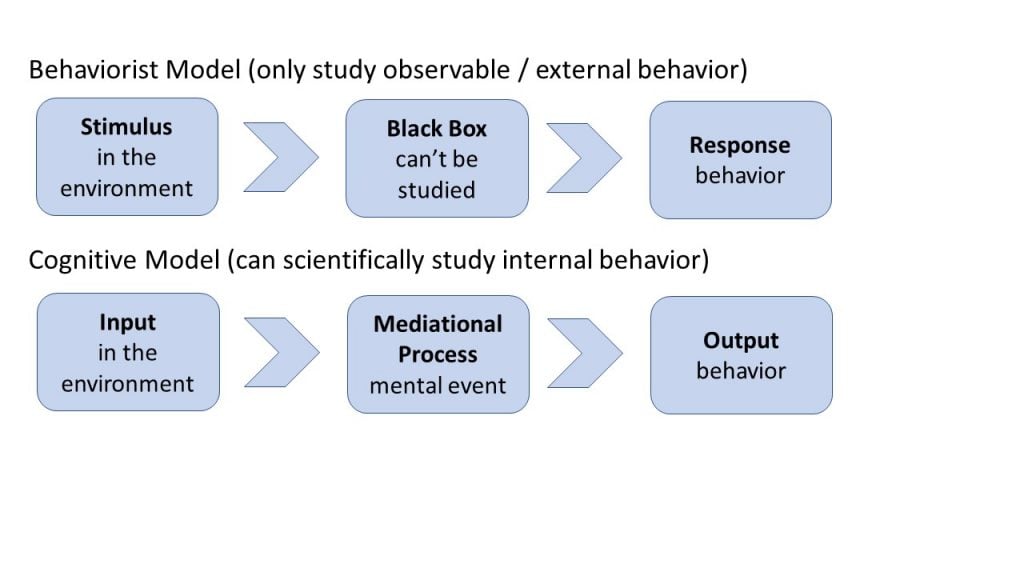Latent learning is a type of learning which is not apparent in the learner’s behavior at the time of learning, but which manifests later when a suitable motivation and circumstances appear. This shows that learning can occur without any reinforcement of a behavior.
Edward Tolman is widely credited with discovering and disseminating the concept of latent learning through his experiments in the 1930s.
While the broader idea that learning can occur without immediate reinforcement might have been discussed or observed in various forms earlier, Tolman’s systematic experiments with rats in mazes clearly demonstrated and popularized the specific concept of latent learning in psychology.
Edward Tolman argued that humans engage in this learning daily as we drive or walk the same route daily and learn the locations of various buildings and objects. Only when we need to find a building or object does learning become obvious
Tolman conducted experiments with rats and mazes to examine the role of reinforcement in how rats learn their way through complex mazes. These experiments eventually led to the theory of latent learning.
Examples
An example of latent learning in children is when a child watches their parents drive multiple times without actively trying to learn the process.
Later, during a toy car game, the child mimics the steps of starting a car, checking mirrors, and using indicators, even though they’ve never been formally taught or reinforced for learning these actions.
The child’s earlier observations became evident when there was a relevant situation to apply the knowledge.
Cognitive maps as an example of latent learning in rats
Tolman coined the term cognitive map, which is an internal representation (or image) of an external environmental feature or landmark.
He thought that individuals acquire large numbers of cues (i.e., signals) from the environment and could use these to build a mental image of an environment (i.e., a cognitive map).
By using this internal representation of physical space, they could get to the goal by knowing where it is in a complex set of environmental features. Shortcuts and changeable routes are possible with this model.
In his experiments with rats in mazes, Tolman observed that even without direct rewards, rats seemed to develop a “mental map” of the maze. When later introduced to a reward, these rats could navigate the maze more efficiently than those without prior exposure, suggesting they had learned about the maze (latent learning) even without reinforcement.
Aim
To demonstrate that rats could make navigational decisions based on knowledge of the environment, rather than their directional choices being dictated by the effects of rewards.
Procedure
In their study, 3 groups of rats had to find their way around a complex maze. At the end of the maze, there was a food box. Some groups of rats got to eat the food, some did not, and for some rats the food was only available after 10 days.
In their famous experiments Tolman and Honzik (1930) built a maze to investigate latent learning in rats. The study also shows that rats actively process information rather than operating on a stimulus response relationship.

Group 1: Rewarded
- Day 1 – 17: Every time they got to end, given food (i.e. reinforced).
Group 2: Delayed Reward
- Day 1 – 10: Every time they got to end, taken out.
- Day 11 -17: Every time they got to end, given food (i.e. reinforced).
Group 3: No reward
- Day 1 – 17: Every time they got to end, taken out.
Results
The delayed reward group learned the route on days 1 to 10 and formed a cognitive map of the maze. They took longer to reach the end of the maze because there was no motivation for them to perform.
From day 11 onwards, they had the motivation to perform (i.e. food) and reached the end before the reward group.

This shows that between stimulus (the maze) and response (reaching the end of the maze) a mediational process was occurring the rats were actively processing information in their brains by mentally using their cognitive map (which they had latently learned).
Critical Evaluation
Strengths
-
Beyond Behaviorism: Latent learning challenged the dominant behaviorist idea that reinforcement is necessary for learning. It broadened the understanding of how and when learning occurs to include cognitive factors, such as information processing.

-
Support from Experiments: Edward Tolman’s maze experiments provided empirical evidence for latent learning, solidifying its legitimacy in the field of psychology.
-
Explains Everyday Learning: The theory accounts for how we often learn from our environment even when there isn’t a clear reward or feedback. This aligns with many everyday learning experiences.
-
Cognitive Emphasis: Latent learning paved the way for a more cognitive approach to understanding learning, emphasizing mental processes and internal representations.
Weaknesses
-
Measurement Challenges: Since latent learning is not immediately observable, it can be difficult to measure and quantify.
-
Over-reliance on Animal Studies: While Tolman’s experiments were groundbreaking, they were primarily conducted with rats. Extrapolating findings from animal studies to human behavior can be problematic.
-
Limited in Scope: Latent learning mainly addresses situations where learning is not immediately apparent. It doesn’t provide a comprehensive view of all learning processes or explain why some learned behaviors might manifest immediately while others don’t.
-
Ambiguity in Mechanism: While latent learning describes a phenomenon, it doesn’t fully elucidate the underlying cognitive mechanisms responsible for this type of learning.
References
Tolman, E. C., & Honzik, C. H. (1930). Introduction and removal of reward, and maze performance in rats. University of California Publications in Psychology.
Tolman, E. C. (1948). Cognitive maps in rats and men. Psychological Review, 55(4), 189.
FAQs
What is the difference between latent learning and observational learning?
Latent learning refers to knowledge acquired without immediate reinforcement, becoming evident when there’s a reason to use it. Observational learning, on the other hand, involves learning by watching and imitating others.
While latent learning is about internalizing information without immediate outward behavior, observational learning emphasizes learning through modeling or mimicking observed behaviors.
What is the difference between implicit and latent learning?
Implicit learning involves unconsciously acquiring knowledge about patterns and structures, typically without awareness that learning is occurring.
Latent learning refers to acquiring knowledge without immediately demonstrating the learned behavior, but it becomes evident when a relevant situation arises.
Both deal with learning outside of conscious awareness, but while implicit learning emphasizes the unconscious process, latent learning emphasizes the delay in demonstrating the acquired knowledge.

